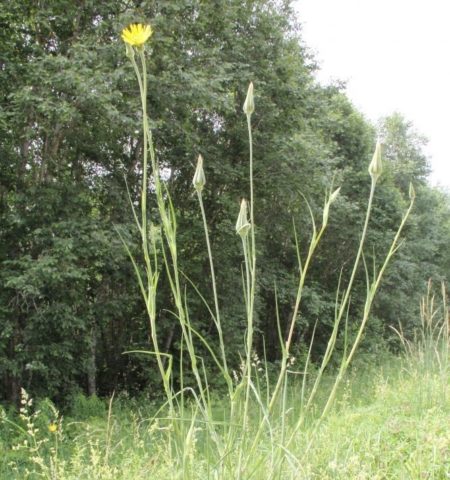Content
In ancient times, people appreciated what the land gives them. They prepared various decoctions from plants, which had a healing effect on the body, or added them to food. One of the most commonly used was the meadow goat. The plant still grows in Europe, Africa and the United States, and some gardeners grow it in their summer cottages.
Description of meadow goatbeard
If we talk about the appearance of the plant, then it has branchy stems of a pink or purple hue. Their height sometimes reaches 1.2 m, but most often does not exceed 50 cm.

If you look at the photo of the meadow goat, we can conclude that the flower resembles an ordinary dandelion
The roots of the plant are large and reach 4 to 10 cm in length. It has large leaves, which are characterized by a linear-lanceolate shape and rich green color. It begins to bloom in mid-June. Peduncles mainly open in the morning hours, and their closure occurs in the afternoon.
The fruits of the meadow goat are a smooth achene that resembles a fluffy crest. Seeds sprout every year for 3 years.
Useful properties of meadow goatbeard
This plant is considered very useful, because it contains a large number of trace elements necessary for the body:
- vitamin PP;
- vitamin C;
- B vitamins;
- iron;
- magnesium;
- sodium;
- selenium;
- zinc;
- phosphorus.
In addition, meadow goat is rich in protein, fiber, ash components and polyunsaturated fatty acids.

Some varieties of the plant are used as a low-calorie vegetable crop, because the root has an exquisite oyster flavor.
Meadow goat is often included in folk remedies, since it has a diuretic, antiseptic, wound healing, anti-inflammatory and choleretic effect.
Eating goat grass roots helps to increase blood insulin levels and lower sugar levels, thereby fighting diabetes. It can also be used for weight loss as it burns fat quickly and efficiently. The use of the plant normalizes biochemical processes in the body. Improves fat and carbohydrate metabolism. The brain is stimulated.
Application in folk medicine
Meadow goatbeard is often used for the preparation of folk remedies. Such treatment helps to quickly remove toxins from the body, normalize appetite and improve peristalsis, increase blood flow, relieve chronic constipation, increase blood clotting and prevent the development of internal bleeding.
Most often, an aqueous infusion is prepared from the plant:
- Pour 1 tbsp into a thermos. l. dried goatbeard, pour a glass of boiled water.
- Let it brew for at least 5 hours. Then they filter.
- The ready-made infusion should be taken in 1 tbsp. l. 5-8 times a day.
The broth is suitable as an expectorant in the treatment of colds, bronchitis or pneumonia. It is recommended to take it for renal pathologies and edema. Can be used to eliminate insomnia.
The plant is used in other cases:
- With purulent wounds, ulcers, dermatosis and eczema, juice should be squeezed out onto the affected areas. Compresses made from gruel gruel also help.
- Steamed or fresh leaves help with abscesses.
- Shredded leaves heal bedsores.
- You can bathe babies who have various rashes on their skin in broth broth.
- With the help of alcohol tincture, mouthwash is performed. The remedy helps with stomatitis, eliminates bad breath.

Meadow goatbeard - a universal remedy for many diseases
It can also be used for various articular pathologies. Alcohol tincture is rubbed into the area where the pain syndrome is observed. And compresses are applied at night. Thus, the mobility of the joints improves, unpleasant symptoms disappear.
Limitations and contraindications
Meadow goatbeard has only one contraindication - increased susceptibility to plant components. With caution, folk remedies from goat bark are recommended for women during pregnancy and lactation, as well as for small children under 6 years of age.
Collection and procurement of raw materials
It is better to dig up the roots of the meadow goatbeard after the first frost. It is not recommended to take old root crops, as they accumulate harmful components. You need to get the plant out carefully, without touching the stems and roots. If the plant is damaged, then it cannot be stored.
Whole roots and stems are placed in a cool place until next year. If the meadow goat grower grows in the garden, then you can not dig the garden bed, but cover it with woven material for the winter. In this way, the plant is stored until spring, and then they enjoy the taste of fresh fruits.
Cooking applications
Meadow goat is used not only for the treatment of various diseases, but also in cooking. This plant is a valuable dietary product and is suitable for those people who dream of losing weight.

Leaves, roots and stems are used in cooking
Previously, all parts of the meadow goat are washed, beaten off and placed in boiling water to eliminate the appearance of a bitter taste.
The roots are peeled and boiled in salted water for 5-7 minutes. The stems and leaves are used to make side dishes or soups.
There are several popular recipes:
- Cooking goatbeard with egg. The root is cut into small pieces, placed in a frying pan greased with sunflower oil. Pour over beaten egg, add green onions. Bake in the oven until tender.
- Cooking vitamin salad. To do this, you need goatbeard leaves, green onions, peas. All ingredients are mixed and seasoned with sour cream. To improve the taste, you can add boiled potatoes or fresh cucumber.
- Roasted goatroot roots. This dish turns out to be very tasty and satisfying. To begin with, the roots are boiled in salted water, peeled. Then they are rolled in breadcrumbs, transferred to a frying pan. Fry for 7-10 minutes.
Instead of tea, you can drink broths from goatbeard, chamomile and mint. But you shouldn't overuse such dishes. It is enough to eat goatbeard 2-3 times a week.
Landing rules
If gardeners decide to start planting a crop, then you need to know that the plant is self-sowing, and therefore can appear anywhere. This is often frustrating.
If this does not frighten, then it is better to use fertile soil for planting.
Acidic and clayey soil will not work either. Growing in such soil will lead to the external deformity of the plant.
It is recommended to plant seeds in late May and early June. Before this, the soil is prepared. To do this, it is fertilized and covered with polyethylene. The garden bed is made large, as the roots sometimes grow up to 30 cm in length.
Growing features
In order for the culture to grow well, it needs to be periodically fed and watered. Do not forget about weeding and loosening the soil.

The plant belongs to unpretentious crops
In the first year, the peduncles are removed. If you do not adhere to this rule, then the roots will be very tough. But there is no such product.
Diseases and pests
Meadow goatbeard loves dry soil more, so it is not worth overfilling. If you do not follow this rule, then the earth will quickly become covered with mold, which will lead to the death of the root system.
Conclusion
The meadow goat is an unpretentious plant to care for, and at the same time very useful for the body. It can be used to treat various diseases, or simply be eaten as a vegetable side dish. If you don't like the goatbeard, then it can also be used to decorate the garden. Many summer residents create beautiful garden paths and hedges.








